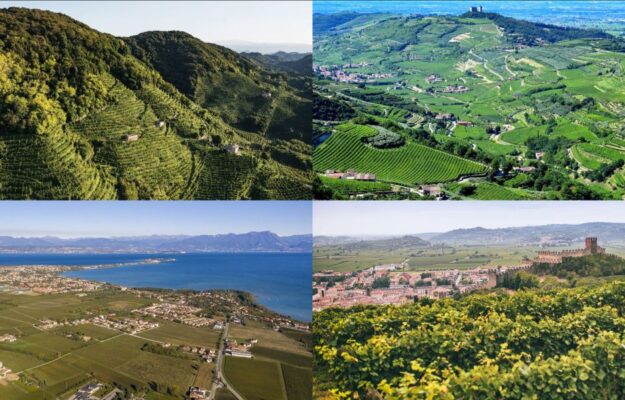The wines of Valpolicella, those of the “Prosecco galaxy”, the Pinot Grigio of the Venezie, passing through Soave, the Colli Berici, the territories of Lugana, Lessini Durello, Colli Euganei, Garda and Bardolino, Custoza, and more: the Veneto region, with its many appellations of absolute value and established in the world, and with those emerging, is a leading Italian wine region, especially on the export front, with 2.8 billion euros in 2023, out of 7.7 of total Italy, a trend confirmed in the first three months of 2024, with Veneto exports at 663.3 million euros, out of 1.8 billion of Italy. A region that, like all others, looks to the grape harvest that in some areas has already begun, and in others is about to kick off, with some optimism about the quality of the grapes, and an estimated production of between 13.3 and 14.2 million quintals, a variation between -5% and +5% on 2023, due to the combined effect of some production losses linked to some, to date contained, hail and a few phytosanitary problems (more accentuated for those who do organic), “compensated” by the entry into production of new plants. Summary data, to be taken with due caution given the period and the variability of the weather, and also considering the great size and variety of the “Veneto vineyard”, from the focus of the Veneto Region and Veneto Agricoltura on grape harvest forecasts in Veneto, in the Northeast, in the main Italian wine regions, and in France and Spain.
“I’m really curious to see how the situation will evolve”, said Riccardo Velasco, director of Crea in Conegliano, “given the clear meteorological divide: on the one hand, in the Center-North we had an excess of rainfall, which brought with it the risk of fungal attacks, fortunately managed quite well thanks to prevention. However, Southern Italy will inevitably pay the price of the severe drought, with serious production losses. From a quality and quantity point of view, I have the feeling that the situation has improved compared to last year, but we are also aware of the large surplus present in many wineries, which could create some problems with regard to grape payments, as warehouses have not yet been completely emptied. Looking ahead to 2024, I expect good quality grapes, especially in Central Italy, where the rains have been abundant, but not excessive. The North, as always, will do well, while I feel very sorry for the southern regions, where the lack of irrigation infrastructure has aggravated the situation”.
In particular, looking at the Veneto region, the green light for the harvest has already occurred as of last week, 3-5 days earlier than the usual dates for the earliest cultivars (Pinot and Chardonnay for sparkling wine bases), whose clusters have already fallen or are falling these days in the baskets. Harvesting of all other varieties will follow: Glera (Prosecco) is expected to start on September 10, Merlot on the 12th, Corvina on the 18th, Garganega on the 25th, just to name a few of the main grape varieties from Veneto. Looking more in detail at the territories, in the province of Belluno production is expected to be substantially in line with last year's (+2/3%), except in areas affected by hailstorms. In Padua and Rovigo, on the other hand, forecasts are more mixed depending on variety: production is expected to be +5/10% higher than 2023 for Glera, Pinot, and Chardonnay, a drop in production for Moscato and Raboso, while Merlot should be stable.
In the province of Treviso, Glera production is expected to increase (+20%) due to the entry into production of new young plantings and, instead, a reduction in the quantities of red grape varieties (0/-5%), higher for non-Docg/Docg varieties, and especially for other white grape varieties (-15%). In Venice, more favorable climatic conditions on 2023, and the adoption of improved agronomic practices lead to expect a production increase of about +3/5% for the main varieties and to a more accentuated extent for the Glera variety (+10%) by virtue, in particular, of the entry into production of new vineyards; stable, on the other hand, the quantities of Chardonnay. A greater presence of thermal stress, water excess and functional stress leads to estimates of production reductions in the range of -10/15% for the main varieties in the province of Vicenza, both for white (Glera, Garganega and Vespaiola) and black (Merlot and Cabernet) grapes, while for Pinot Grigio grapes, a more significant decrease in quantity is expected (-20/25%). Temperature swings at the end of April compromised production in many valley floor vineyards and in several lowland areas in the province of Verona; spring rains and phytosanitary problems negatively affected white berry grape varieties to a greater extent, for which production drops in the range of -10/20% are expected, while for red berry grapes expectations are for substantial stability in production yields.
In the Northeast, in the two autonomous provinces of Trento and Bolzano, lower production of about -10/15% is expected, on the one hand due to more unfavorable weather conditions on 2023, lower fruit set and fewer berries and bunches present, a situation only partly offset by the entry into production of new vineyards. On the other hand, these aspects have had little or no impact on the expected results in the Friuli-Venezia Giulia Autonomous Region, where, on the contrary, by virtue of fewer hail events on 2023, production is expected to increase by +10% as a precautionary measure, despite the presence of phytosanitary problems (downy mildew).
Copyright © 2000/2025
Contatti: info@winenews.it
Seguici anche su Twitter: @WineNewsIt
Seguici anche su Facebook: @winenewsit
Questo articolo è tratto dall'archivio di WineNews - Tutti i diritti riservati - Copyright © 2000/2025









































































































































































































